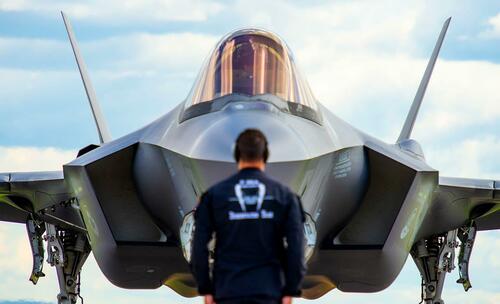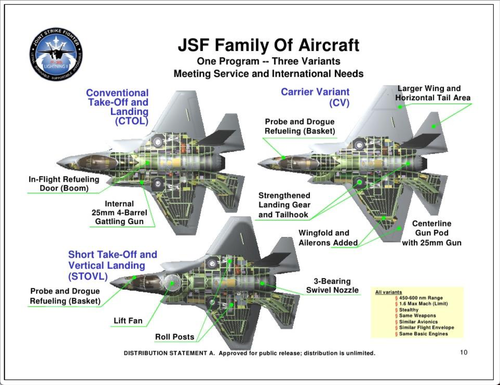
Just three weeks ago Defense News published an extensive investigative report which posed the question in its headline, Lockheed eyes new F-35 parts deal, but can it handle wartime demands? The report introduced:
By the end of the year, a new and unusual deal for the F-35 fighter′s spare parts could be in place — one that would flip the current supply model on its head.
If the proposed performance-based logistics contract works the way F-35 manufacturer Lockheed Martin has promised, it will save the government money, improve the availability of spare parts and give the company greater flexibility on how it assists repairs, such as making it easier to fix a broken part without fabricating a new one.
Fast-forward to Tuesday, and the congressional watchdog Government Accountability Office (GOA) released a devastating report which reveals the entire question of "saving the government money" to be laughable and way off.

Bloomberg writes based on the new GOA findings that "The Pentagon can’t account for hundreds of thousands of spare parts worth millions of dollars that are stored worldwide for the US and allies for its costliest weapon, the F-35 jet, according to congressional auditors." So perhaps the Pentagon should think about simply locating the missing ones first before a giant Lockheed parts overhaul is put into place.
Even long before this, going years back, the controversial program to develop the ultra-costly stealth multirole combat aircraft produced periodic headlines like the following in 2020: The Pentagon’s $35 Trillion Accounting Black Hole.
The fact that the Department of Defense has failed to pass a DOD-wide audit for the fifth consecutive year has compounded the problem which has been months or years in the making, to the tune of millions billions lost - which could eventually add up to a one-and-a-half trillion dollars black hole.
This as the GOA report has confirmed the Pentagon's F-35 program office doesn't provide oversight for the parts:
Unlike scores of GAO reports and other assessments that analyze the fighter jet’s cost, schedule and flying performance, the new audit delved into the more mundane and largely invisible work of supporting the aircraft once it’s delivered to international customers. The operation and support bill for the F-35 may reach an estimated $1.4 trillion through 2088.
Allies don’t own parts and tap into the Defense Department’s worldwide shared pool of spares, including engines, tires, landing gear and items such as bolts, screws and fasteners. The Pentagon’s F-35 program office doesn’t maintain accountability over the parts, “the total value of which is unknown,” the GAO said.
It is manufacturer Lockheed Martin which solely "tracks" the records (supposedly), given the Pentagon has been "unable to provide the cost, total quantity, and locations of spare parts in the global spares pool."
According to the GOA report:
The lack of visibility into the inventory “increases the risk of misstatement on DOD’s financial statements and the risk of mismanagement of the F-35 global spares pool,” it said.
All of this comes the same week that multiple media reports and former top US officials have highlighted that contractor price-gouging is common and routine when it comes to the gargantuan defense budget, at taxpayer's expense of course. For example, former Pentagon insiders told Newsweek that the Biden administration's 'blank check' approach to Ukraine has resulted in a massive arms flow to Kiev "no matter the expense." Naturally this has resulted in diminished incentive to engage in serious and timely audits for things like expensive jet parts, and to determine where they are globally.
Lockheed continues to be front and center in these whistleblower and former DoD official tell-alls...
In 2015, Army negotiators discovered that Lockheed Martin and Boeing overcharged the Pentagon and U.S. allies by hundreds of millions of dollars.
— 60 Minutes (@60Minutes) May 21, 2023
“Is it really any different than not giving a Marine enough bullets to put in his clip?” said Shay Assad. https://t.co/ABmphmYzjz pic.twitter.com/snehFTHNwi
Meanwhile, the US continues to modernize its fleet of fighter jets and strategically place them in key US allies, such as Germany, Japan, and South Korea, creating a 'friends circle' of fifth-generation fighters around Russia and China.
Just three weeks ago Defense News published an extensive investigative report which posed the question in its headline, Lockheed eyes new F-35 parts deal, but can it handle wartime demands? The report introduced:
By the end of the year, a new and unusual deal for the F-35 fighter′s spare parts could be in place — one that would flip the current supply model on its head.
If the proposed performance-based logistics contract works the way F-35 manufacturer Lockheed Martin has promised, it will save the government money, improve the availability of spare parts and give the company greater flexibility on how it assists repairs, such as making it easier to fix a broken part without fabricating a new one.
Fast-forward to Tuesday, and the congressional watchdog Government Accountability Office (GOA) released a devastating report which reveals the entire question of “saving the government money” to be laughable and way off.

Bloomberg writes based on the new GOA findings that “The Pentagon can’t account for hundreds of thousands of spare parts worth millions of dollars that are stored worldwide for the US and allies for its costliest weapon, the F-35 jet, according to congressional auditors.” So perhaps the Pentagon should think about simply locating the missing ones first before a giant Lockheed parts overhaul is put into place.
Even long before this, going years back, the controversial program to develop the ultra-costly stealth multirole combat aircraft produced periodic headlines like the following in 2020: The Pentagon’s $35 Trillion Accounting Black Hole.
The fact that the Department of Defense has failed to pass a DOD-wide audit for the fifth consecutive year has compounded the problem which has been months or years in the making, to the tune of millions billions lost – which could eventually add up to a one-and-a-half trillion dollars black hole.
This as the GOA report has confirmed the Pentagon’s F-35 program office doesn’t provide oversight for the parts:
Unlike scores of GAO reports and other assessments that analyze the fighter jet’s cost, schedule and flying performance, the new audit delved into the more mundane and largely invisible work of supporting the aircraft once it’s delivered to international customers. The operation and support bill for the F-35 may reach an estimated $1.4 trillion through 2088.
Allies don’t own parts and tap into the Defense Department’s worldwide shared pool of spares, including engines, tires, landing gear and items such as bolts, screws and fasteners. The Pentagon’s F-35 program office doesn’t maintain accountability over the parts, “the total value of which is unknown,” the GAO said.
It is manufacturer Lockheed Martin which solely “tracks” the records (supposedly), given the Pentagon has been “unable to provide the cost, total quantity, and locations of spare parts in the global spares pool.”
According to the GOA report:
The lack of visibility into the inventory “increases the risk of misstatement on DOD’s financial statements and the risk of mismanagement of the F-35 global spares pool,” it said.
All of this comes the same week that multiple media reports and former top US officials have highlighted that contractor price-gouging is common and routine when it comes to the gargantuan defense budget, at taxpayer’s expense of course. For example, former Pentagon insiders told Newsweek that the Biden administration’s ‘blank check’ approach to Ukraine has resulted in a massive arms flow to Kiev “no matter the expense.” Naturally this has resulted in diminished incentive to engage in serious and timely audits for things like expensive jet parts, and to determine where they are globally.
Lockheed continues to be front and center in these whistleblower and former DoD official tell-alls…
In 2015, Army negotiators discovered that Lockheed Martin and Boeing overcharged the Pentagon and U.S. allies by hundreds of millions of dollars.
“Is it really any different than not giving a Marine enough bullets to put in his clip?” said Shay Assad. https://t.co/ABmphmYzjz pic.twitter.com/snehFTHNwi
— 60 Minutes (@60Minutes) May 21, 2023
Meanwhile, the US continues to modernize its fleet of fighter jets and strategically place them in key US allies, such as Germany, Japan, and South Korea, creating a ‘friends circle’ of fifth-generation fighters around Russia and China.
Loading…







